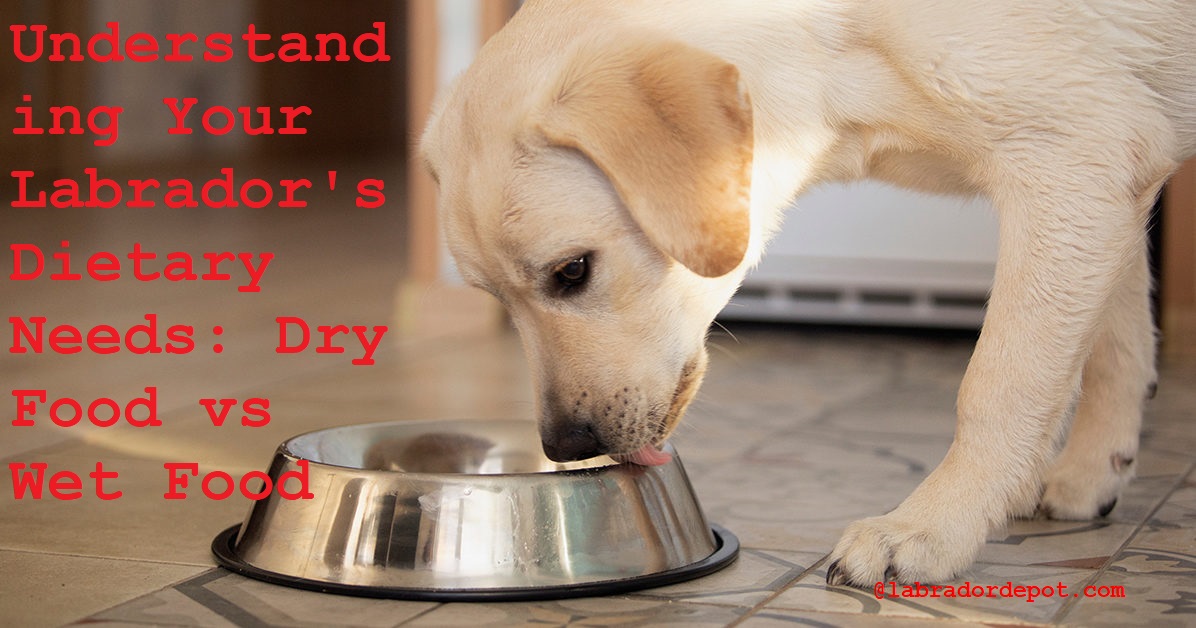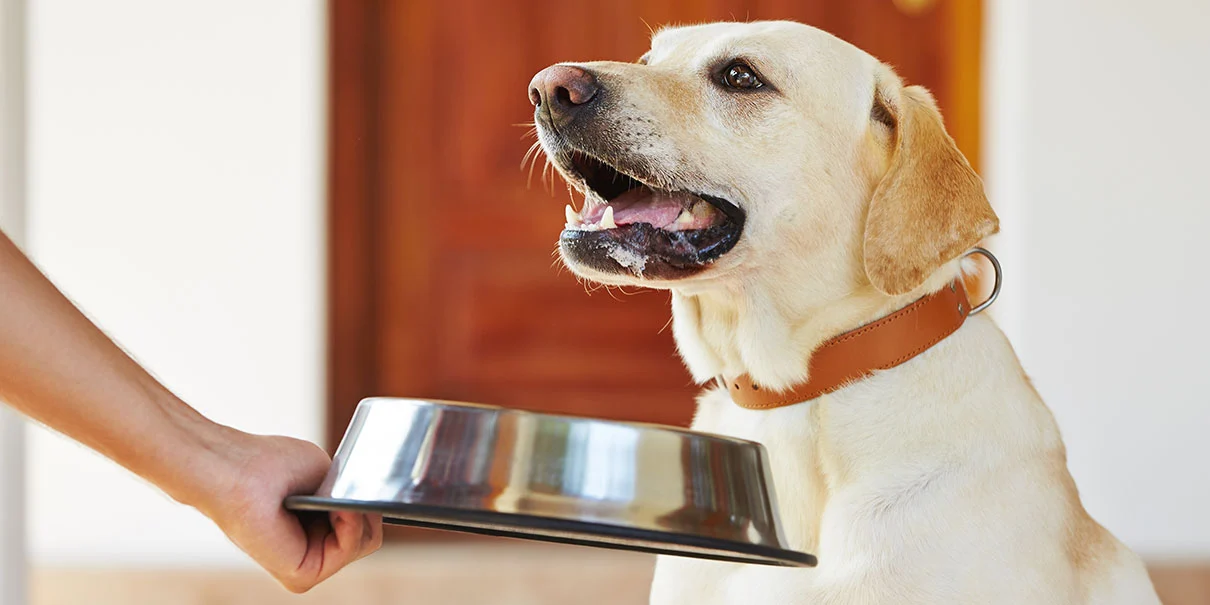Confused about the dietary needs of your Labrador? You are not alone!
This guide will provide the answers to give your pup the best nutrition for their size and activity level. From crunchy kibbles to succulent canned food, you’ll get all the information you need to make an informed decision.
Labradors are active and energetic dogs, known for their playful and friendly personalities. They are often considered one of the most popular breeds in the world, making them a popular choice for families.
As part of becoming a responsible pet owner, it is important to understand the dietary needs of your Lab so that you can provide them with a balanced nutrition plan. This guide will explore the benefits of both dry food and wet food options for your Labrador’s meals as well as discuss how often your Lab should eat. By understanding their dietary needs, you can ensure that your beloved pup is always happy and healthy!
Factors to Consider When Choosing Between Dry and Wet Food
When it comes to choosing the right food type for your Labrador, there are many factors that need to be taken into consideration. It is important to not just make a choice based on cost, availability or convenience. Here are some of the important factors you should take into consideration when deciding between dry and wet food for your Lab.
Nutrient Profile: The nutrient profile of dry and wet food can vary greatly. Dry foods generally have a higher concentration of protein, fat and carbohydrates than wet foods do. In some cases, wet food may require supplementation in order to ensure adequate nutrient intake.
Palatability: The palatability of dry and wet food options can also vary significantly. Many Labradors enjoy eating both types of food, but it is important to take your dogs unique tastes into account before making any decisions.
Cost: Cost is another factor that needs to be taken into consideration when selecting dog food for your Labrador Retriever. In general, dry food typically costs more than canned/wet due to the additional processing involved in its preparation and packaging – however this cost difference often varies by brand and store location.
Storage & Preparation: Dry food is much easier to store since it does not need refrigeration; canned type may need to be stored in the refrigerator upon opening or consuming part of the contents inorder prevent spoilage due to the high moisture content present in most canned options Store-bought wet food can also usually be served without much preparation or effort which makes it a convenient option for busy pet owners.
Your dog’s individual needs and preferences
When choosing the right food for your Labrador, you should consider your pup’s individual needs and preferences. Different dogs have different nutrient requirements depending on their age, activity level, size, breed and medical history. That said, some general guidelines can help you decide if dry food or wet food is best for your pup.
Dry kibble is often easier to feed to your pet than wet food because it lasts longer in storage and doesn’t require refrigeration. However, this type of food isn’t always the most nutritious or enticing to Labradors. Quality dry kibbles should offer a balanced mix of proteins, carbohydrates and fats for energy and nourishment. Make sure that the ingredients list includes mostly whole foods like fresh meats, vegetables and grains instead of processed by-products or fillers.
Wet food typically contains more moisture than dry kibble making it more palatable for picky eaters. It may also contain more minerals and vitamins since some of these nutrients are lost during the kibble processing process. When selecting wet food look for natural ingredients with added vitamins and minerals to support your dog’s health. Additionally, check that none of the ingredients could potentially trigger allergies in your pup such as grains or dairy products that are low in nutritional value but high in calories.
As part of a nutritionally balanced diet ensure that you provide a variety of both wet and dry foods so that all nutritional needs are met – including essential fatty acids – as well as providing variety which will help ensure they don’t become bored with their meals!
Your budget
When budgeting for your Labrador’s food, it is important to consider both wet and dry options. Although cost is typically the most influential factor when purchasing both wet and dry foods for your dog, it should not be the only factor in determining what type of food is right for them. There are several factors to consider when deciding which food is best for your Labrador: nutritional content, ingredients, palatability, availability and price.
Nutritional content varies between wet and dry foods; while wet foods tend to offer more moisture content, calories per gram tend to be higher in dry foods. Many premium brands also offer more than one type of nutrient density as well as tailored nutrient profiles designed specifically for different life stages (e.g., adult versus puppy) or lifestyle needs (e.g., active versus sedentary). When considering different types of food, look at the label to make sure that the product you are buying contains all of the necessary nutrients your pup needs for a balanced diet.
Ingredients can also play an important role in selecting a diet option; many blends contain multiple sources of protein such as chicken meal or turkey meal rather than just one source. Additionally, look out for fillers and add-ins like grain-free carbohydrates or novel proteins that may not be suitable or beneficial for all dogs. If you’re unsure about a product’s ingredients list, seek advice from your veterinarian or research reviews online before purchasing it.
Another factor that can affect the total cost of feeding your Lab is palatability; dry food does not have much flavor and therefore can become boring quickly if eaten regularly over an extended period of time – this can lead to issues with finickiness with changes in flavor resulting in reduced appetite and picky eating habits if switched more frequently than advised by your veterinarian. Wet food tends to be more moist and flavorful which helps keep pups interested enough in their meals so they receive adequate nutrients throughout their life stages which supports overall health.
Availability should also play a part in deciding how much you will pay – not only do certain product lines contain unique flavors that may only be available at certain pet retailers but there may also be regional restrictions on some products due to import/export requirements or state law restrictions regarding specific ingredients allowed/not allowed within pet foods produced/sold within given locations (e.g. Florida has very particular laws on ingredients used within pet foods made & sold within its state borders).
Finally price differs between brands – while some premium diets will cost significantly more than their basic grade alternatives there are still generally several cheaper brands available without sacrificing quality nutrition & ingredient lists so shop around first & compare prices before making an informed decision ultimate goal is finding economical way provide high quality nutrition with appropriate macro & micronutrient.
Your lifestyle and schedule
Your lifestyle and schedule can greatly affect your Labrador’s dietary needs. If you are a busy person who does not have adequate time for meal preparations, then dry food is the best choice for your pet as it requires no special preparation. Dry food can also be left in your pet’s food bowl all day, allowing him more freedom to snack at his leisure.
On the other hand, if you have more time on your hands to prepare nutritious meals for your pets in advance, wet food is ideal as it contains higher levels of water which helps keep them hydrated. Wet foods also require less chewing compared to dry foods, making them easier on digestion and absorption. However, wet foods need to be eaten fresh so they are best prepared shortly before mealtimes or stored in the refrigerator or freezer if needed.
Potential health concerns
When it comes to dry and wet food, there are potential health concerns that should be taken into consideration before offering your Labrador either type of diet. Even though most dogs do not have an issue with consuming both wet and dry food, it is important to make sure the food is providing the correct nutrition for your pet.
Dry Food: Dry food may contain more carbohydrates than wet food, which may cause issues in Labradors who have sensitivities to these types of foods. Additionally, dry food often contains preservatives that can increase the shelf life but may also cause digestive upset in some dogs.
Wet Food: Wet food is typically higher in fats and proteins than dry food, however the fatty content can cause weight gain in certain dogs so should be taken into account. Additionally, some forms of wet dog food contain added sugar or seasonings which can be negative for a pet’s health.
It is important to speak with your veterinarian if you are considering transitioning your Labrador from one type of diet to another. This will ensure your pet gets all the necessary nutrition while avoiding any potential complications associated with dietary changes such as weight gain or digestive upset.
III. Feeding Your Labrador: Tips and Best Practices
Proper nutrition is an essential part of keeping your Labrador happy and healthy. However, it can be difficult to decipher which type of food is best for your pup. This section explains the differences between dry and wet food, as well as some tips for feeding your Labrador.
Dry Food: Dry dog food (kibble) has a longer shelf life than wet food and can last up to six months if stored in an airtight container in a cool, dry place. Kibble is usually made from grains, vegetables, and proteins such as chicken or fish, plus vitamins and minerals. It is also generally less expensive than wet food.
Wet Food: Wet dog food typically comes in cans or pouches, although there are now also freeze-dried options available too. It contains similar ingredients to dry kibble but in a softer texture with more moisture content – meaning it’s easier for older dogs to chew and digest. This type of food is often more appealing to picky eaters too!
Tips & Best Practices: No matter which type of dog food you choose, there are certain tips and best practices you should follow when it comes to feeding your Labrador:
- Feed your pup at least twice a day – once in the morning and once at night – using measured portions based on their weight and converted into cups or grams. Doing this ensures that they receive all the nutrients they need without going over their daily calorie intake limit;
- Always have fresh water available;
- Make sure all treats are healthy-source with no added artificial sweeteners or unhealthy additives;
- If you decide to switch the type of dog food you feed your pup (e.g., from wet to dry), do so gradually over time rather than giving them the new brand all at once;
- Consistency is key when it comes to diets; stick with what works!
How much to feed your dog
When caring for your Labrador Retriever, it’s important to understand their dietary needs and how they differ from other breeds. The first consideration is the amount of food you’re providing to your dog. As with all breeds, the age, size and activity level of your Lab will influence the amount of food he needs.
In general, an adult Labrador Retriever should consume between 2.5 and 3 cups of high-quality dry dog food each day divided into two meals. Active Labs may require up to 4 cups per day depending on size and individual needs. Puppies will need a diet consisting of both dry kibble and wet food as nutrient density should always be taken into consideration.
Dividing meals throughout the day will help your Lab maintain a healthy weight as well as better regulate their body temperature during strenuous activities or in hot climates since their bodies will not be subjected to long periods without fuel or overworking for long periods without rest. It’s also important that you don’t let the portion sizes get too big at once or leave food out all day which encourages ravenous eating habits in some dogs.
Frequency of feeding
Frequency of feeding is an important consideration when planning your Lab’s diet. Puppies require more frequent feeding than mature dogs, as they are in a period of rapid growth and require many small meals throughout the day to meet their nutritional needs. Adult Labradors should be fed two balanced meals per day, adjusting portions size based on the activity level.
Overall, how often your Labrador will need to eat will depend on their weight and activity levels. When determining meal frequency and portions size, talk with your veterinarian about what size is best for your dog’s age and lifestyle. In general, most Labradors should be fed twice daily: once in the morning and again at night. This can help prevent waist gain.
No matter whether you opt for a dry food or wet food diet for your Lab, it is essential to have consistency with meal plans; this helps keep metabolic functions functioning optimally as well as preventing stomach upset from different foods being eaten each day. Remember, too much or too little food can both have adverse effects on energy levels throughout the day and lead to gastrointestinal distress. Always stick to recommended portion sizes and monitor your pet’s overall health regularly with routine vet appointments or check-ins at home!
Importance of monitoring your dog’s weight
Maintaining a healthy weight is an essential part of keeping your Labrador healthy, and this means making sure that they are not over or underfed. Regular veterinary check-ups will track weight changes, but it is also important to monitor their weight regularly at home. The amount and type of food your dog eats should be adjusted according to their energy expenditure, health and age. An ideal goal is to feed a balanced diet that provides all the necessary nutrients in the appropriate amounts for your dog’s individual needs.
Weight gain can occur when feeding an unbalanced or excessive amount of food (including treats). This can result in obesity which can lead to serious medical conditions, including diabetes, arthritis and heart disease. Dogs should weigh about 8kg for a standard sized Labrador Retriever, but bear in mind that male Labradors tend to be heavier than females. If you notice significant changes in your pet’s body frame or size over time, make sure you consult with your vet as soon as possible.
When it comes to feeding Labradors, there are two main types of diets: dry and wet (canned) food. Dry food may provide more meal structure for dogs who need it and keep them feeling fuller for longer; however wet food can be beneficial if your pet has dental issues – this option helps reduce the buildup of tartar (also known as plaque). Ultimately, what’s best for each individual Labrador will depend on its particular needs; hence why monitoring weight becomes important!
The role of treats and table scraps
Using treats and table scraps as part of your Labrador’s diet can help support their health and training, but it can also add unwanted calories. While snacks and leftovers may be beneficial for speeding up the learning process, they should come in moderation to prevent overfeeding and weight gain.
Regardless of how much your dog likes a particular treat or human food, it is important to remember that treats should make up no more than 10 percent of their total daily calorie intake. Treats should be chosen carefully with ingredients, size and quantity all kept in mind. Most dog owners opt for smaller treats like Zukes Mini Naturals or Let’s Bark Turkey Chips for training sessions.
In general, when feeding table scraps to your Labrador, look for lean proteins such as cooked fish or chicken. Carbohydrates, fats and spices should be avoided whenever possible; however, small amounts of plain cooked vegetables can benefit your dog’s diet in a number of ways. Just make sure that you are monitoring the amount they are consuming so they are not eating too many calories.
Although many people feel that adding treats and bits of human food to their Labrador’s diet is an important part of their ownership experience, it’s important to recognize the dangers that overindulgence can bring about. By keeping treats at a minimum each day and selecting healthy options when possible, you can prevent any negative health effects such as obesity or digestive issues from occurring.
When to consult with a veterinarian
If you are ever uncertain about the best type of diet to provide for your Labrador, it is important to consult with a veterinarian. They will be able to assess your pup’s health and lifestyle, and can recommend an appropriate diet as well as provide advice on portion size and nutrient balance.
Veterinarians may also have special recommendations if your pup is suffering from any health issues or allergies that make certain types of food inadvisable or need extra careful attention. For example, if your pup has specific weight goals then a veterinarian can help craft a diet that meets those goals without missing out on any essential vitamins or minerals.
Additionally, if there are any questions about introducing wet food for the first time into your Labrador’s diet, it is best to consult with a veterinary professional who can monitor the transition closely and offer advice on this change in diets. The same applies when reintroducing dry food after an extended period of wet food consumption; consulting with an animal nutritionist may help ensure that all dietary needs are being adequately met during this switchover.
Conclusion
In conclusion, as a Labrador owner you have to understand that the best diet for your dog will depend on the individual. Dogs with allergies and health conditions may need to be on a different type of diet compared to other dogs.
Dry food can offer nutritional value and is often more convenient than wet foods. Wet foods contain more moisture therefore making it higher in protein however its not always an option if your pup isn’t eating well or if they prefer dry kibble as their main dietary choice.
You should always talk with your veterinarian before making any changes to your Labrador’s eating habits and make sure that whatever choice you decide, that it fulfills all their dietary requirements in order to keep them healthy and happy!
FAQ’s
Is wet or dry food better for labs?
Both wet and dry dog food can be nutritionally balanced, but wet food can be beneficial for dogs who need more hydration in their diet.
How much dry dog food equals wet dog food?
There is no standard conversion of dry dog food to wet dog food. Follow the feeding instructions on the food package or consult with a veterinarian.
Should Labradors have wet food?
Labradors can benefit from wet food as it can help increase their hydration levels, but dry food can also be a nutritionally balanced option.
Should I mix wet and dry dog food?
Mixing wet and dry dog food can provide a variety of textures and flavors, but be sure to adjust the amount of food you are feeding your dog accordingly.
Can dogs eat wet food everyday?
Dogs can eat wet food every day as long as it is nutritionally balanced and meets their dietary needs.
Is it OK to feed a dog dry food only?
Yes, dogs can be fed dry food only as long as it is a nutritionally balanced option and meets their dietary needs.
How much wet food equals 1 cup of dry dog food?
There is no standard conversion of wet dog food to dry dog food. Follow the feeding instructions on the food package or consult with a veterinarian.
Why is wet dog food better than dry?
Wet dog food can be beneficial for dogs who need more hydration in their diet and can provide a variety of textures and flavors.
What is the best food for Labs to prevent shedding?
A diet that is rich in omega-3 fatty acids can help reduce shedding in Labradors. Some good food options include salmon, flaxseed, and fish oil supplements.
Why won’t my Labrador eat dry food?
There could be many reasons why a Labrador won’t eat dry food, including dental issues, changes in appetite, and food preferences. It is best to consult with a veterinarian to determine the underlying cause.
See Also-
- Best dry food for Labrador
- Best food for labrador puppy
- Best hair brush for Labrador
- Best harness for Labrador
- Best shampoo for Labrador


